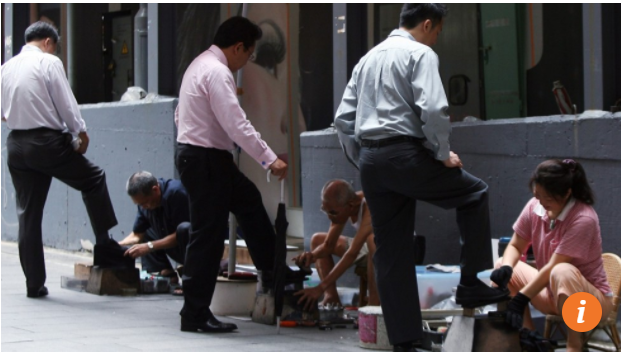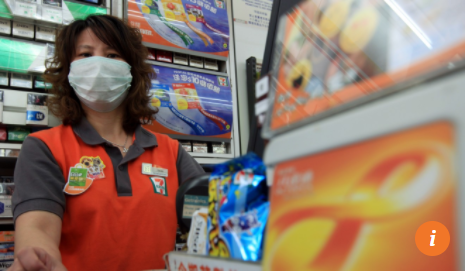QR code wars: Hong Kong’s Octopus targets shoe shiners with e-payment system
Competition from mainland giants like Alipay and WeChat Pay means city’s pioneer in electronic transactions has to keep up with mobile scanning method

Shoe-shining stalls in Hong Kong’s bustling business hub, Central, have emerged as the next industry targeted by electronic payment service providers, as a local operator seeks to fend off rising competition from mainland Chinese giants.
Octopus, the smart card operator which has dominated the Hong Kong market for the past 20 years, rolled out a trial on a new QR code feature several weeks ago, including a real-time online payment via phone widely used in mainland China.
At the busy Theatre Lane, three cobblers are already polishing up their act by allowing customers to settle payments through Octopus QR codes.
The QR code method differs from the Octopus cards’ near-field communication (NFC), a scanning technology where payments are usually cleared at a later time.
If the move takes off, it will mark a new era for Octopus, which currently has 33 million cards in circulation.
One of the shoe shiners, who gave her name as “Sister Ying”, said the QR code feature was not popular yet and she had only encountered a few patrons using it. Customers must have the Octopus app installed on their smartphones, and their accounts must be topped up in advance.
During a transaction, users scan the merchant’s QR code with their phones, and their accounts are then debited according to the payment amount.
Sister Ying admitted it was not as convenient as paying with the tap of an Octopus card, or even cash.
“[But] sometimes it’s not about whether we want to get on board or not – the world is always shifting, and we have to keep up with the times,” she said.
Small businesses like Sister Ying’s are generally reluctant to adopt mobile payment, as they do not want their humble profits eaten away by administration fees.
Currently Octopus waives the service charge for QR code payments, but a 1.5 per cent fee will be levied in the future.

Octopus, launched in 1997 for the sole purpose of settling public transport fares with a simple touch-and-go process, became so widely used in the city that commerce chief Edward Yau Tang-wah described it as “a victim of its own success”.
According to Yau, Hong Kong stopped exploring new options after the introduction of the system, which subsequently extended its reach into payment in supermarkets, car parks, access to school campuses, residential and office buildings and even tracking down criminals.
Some 1.2 million first-generation Octopus cards to expire by 2019, as they are not compatible with smartphone app
As smartphone usage penetrates society, Octopus has to catch up with rivals such as Alipay and Tencent’s WeChat Pay, mainland China’s two largest online payment platforms which are expanding rapidly in Hong Kong.
Alipay is a unit of Ant Financial Services Group, an affiliate of Alibaba Group Holding which owns the South China Morning Post.
Francis Fong, honorary president of the IT Federation, said the trend of mobile payments would only become bigger in the years to come.
“Everyone now has a smartphone to complete transactions. This is a big advantage over credit cards, where merchants’ terminals must be connected to a landline,” Fong said.
The mobile payment operators have also crossed swords in wet markets. At Po Tat Market in Kwun Tong, all 43 stalls are equipped with Alipay.
In a stark contrast to traditional markets where transactions are mostly settled by hard cash, QR code stickers are put up everywhere at Po Tat so shoppers can scan and pay with their mobile phones.
Mandy Sze, the owner of 228 grocery shop at the market, has signed up for the technology. She said an average of 10 payments a day were made using Alipay at her stall, totalling about HK$500.
According to Sze, the process is not as complicated as some may think.
“Sometimes we have to guide customers to complete the transaction, but most of the time it’s a trouble-free experience,” she said.
But for Man Shing Vegetables next door, the new technology has its glitches. Its vendor said the unstable internet connection in the market can sometimes affect transactions. “Maybe we’re in a network blind spot. This is sometimes annoying.”
The electronic payment battleground has also expanded to public transport. On Thursday MTR Corporation announced that it would accept WeChat Pay next month, while Alipay is also expected to be available very soon.
![DQmRKgYYp1TzWmvqtnfbMSLZQSgUXinUxqyHyd39HZ8j7gx.gif]
( )
)
Although mobile payments are only accepted at ticket machines – which is less convenient than a simple tap of the Octopus card at station barriers – the move signalled the first time the rail giant is accepting cashless payments other than via Octopus.
On its part to keep up with the mobile payment method, Octopus said it would not reveal further details but added that there would be an official launch by the end of the month.
IT Federation’s Fong said rather than directly competing with its rivals, Octopus should capitalise on its dominant position by helping new entrants set up shop and charging a commission.
“The pie is big in Hong Kong. You can partner with the supermarkets, while I can focus on convenience stores, and so on. It doesn’t have to be cutthroat competition,” he said.
The IT expert also said it was unfair to blame Octopus for the city’s slow development in the mobile payment market.
“I heard that Octopus was ready to launch an electronic wallet function years ago. But it was not until last year that the Monetary Authority issued licences.”
Called stored value facility licences, each mobile payment platform must get approval from the financial regulator to operate in Hong Kong.
Thirteen licences were issued last year. They include WeChat Pay, Alipay as well as O! ePay, the service offered by Octopus.